How to improve the drying efficiency and reduce the heat consumption of the rotary drum dryer has gradually attracted the widespread attention of the enterprise. In order to increase the production and energy saving of the drying system, when designing the drying line, it is necessary to find a reasonable allocation of the drying system; for the completed production line, the drying line should be improved with new technology. In the use of the rotary drum dryer, the most important thing is to ensure that the drying material is evenly distributed, the heat supply is uniform, and the heat exchange is efficient. The following highlights several key technical aspects that need to be addressed.
Reduce the material size and maintain uniform feeding
The finer the material particles, the better the uniformity of the flow, and the smaller the tendency of hysteresis in the system; on the other hand, the smaller the particle size, the larger the heating area and the higher the evaporation intensity.
In contrast, the large particle mass is easy to form a gas film layer and a hard layer to prevent heat transfer and mass transfer of the inner layer material. Therefore, when drying clay or shale, the material should be crushed first.
For wet clay with high viscosity and high moisture, its crushing is a difficult problem. When selecting a crusher, the physical properties of the raw materials must be fully considered. Generally, for materials with obvious plastic deformation, it is preferable to adopt a combination of extrusion and shearing in a static load transmission mode, and it is suitable to use a single-tooth roller or a double-tooth roller crusher.
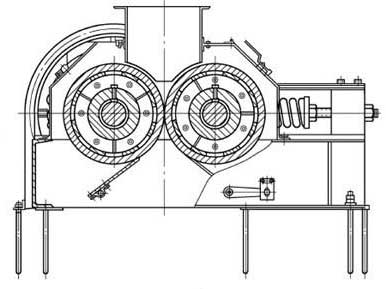
Uniform feeding is a prerequisite for achieving uniform flow of materials. On one hand, it can ensure the balance of the heat load of the rotary drum dryer and the stability of the thermal system, so that the moisture of the dried materials is consistent, and the heat of the hot air furnace and the like is increased, thereby improving the service life of the rotary drum dryer and the electric precipitator; On the other hand, the temperature of the exhaust gas can be easily grasped and controlled. Mechanical feeding generally adopts the method of “lifting machine + intermediate silo + disc feeder” or “tape machine + double flap discharge valve”. The former is suitable for materials with low moisture and low viscosity, while the latter is suitable for materials with high moisture and high viscosity.
Improve feeding method
Almost all the rotary rotor dryer is fed by a skew tube. Due to the high furnace temperature and large load change, the slide tube is washed and oxidized by the hot flue gas, and the deformation and damage phenomenon is very serious, and the replacement is quite troublesome.
What is more serious is that the burnt-bend skew tube often shakes the top of the furnace or fire seal and causes air leakage, which will greatly reduce the thermal efficiency and service life of the rotary drum dryer.
Regardless of whether the pipe is made of steel or cast iron, the problem of short service life cannot be solved well.
In order to extend the service life of the rotary drum dryer feed pipe, the skew pipe can be changed to the “straight pipe + lower groove plate” form. The upper section is straight pipe type, the straight pipe is built into the furnace wall to avoid high temperature oxidation and hot flue gas scouring;
The lower section is the inclined groove plate, which receives the material dropped by the straight pipe, and then slides the material along the inclined surface into the dryer. The chute plate is made of refractory cast iron, and the underside is supported by the refractory bricks.
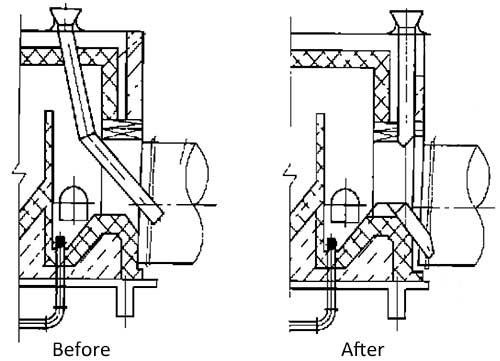
The modification of the feeding pipe should be carried out together with the modification of the hot blast stove and the sealing ring.
Improve the heat furnace
At present, the heat furnaces many companies use mainly includes three types: grate furnace, pulverized coal furnace and boiling furnace. The number of grate furnaces is about 50% to 55 %, and that of pulverized coal furnaces is about 10% to 15%. 25 % to 30 %.
The grate furnace has low thermal efficiency, high labor intensity and high pollution. It has high requirements on the quality of coal, cannot be dampped down for a long time, and has a short service life. However, due to its low one-time investment, it was adopted by most small and medium-sized enterprises before the introduction of the boiling furnace.
The thermal efficiency of the pulverized coal furnace is higher, but the coal quality and coal-fired particle size are higher, and the electricity in the pulverized coal preparation process High consumption, large coal mill wear, high equipment maintenance cost, serious pollution, and no in-furnace desulfurization in the combustion mode, thus limiting its development.
The high-temperature flue gas boiling furnace has a burn-up rate of over 99% and high thermal efficiency. It is characterized by good adaptability to fuel, combustible with various inferior fuels; simple preparation process of fuel; stable heating supply and wide range of load regulation; high degree of automation and good controllability; combustion process is sub-high temperature combustion, NOx generation The amount is small, and after the limestone is mixed, the sulfur-fixing desulfurization in the furnace can be achieved (the desulfurization rate is more than 85%), which has the advantages of environmental protection and energy saving, can enhance the heating, increase the output, and ensure the quality. Fluidized bed burning is a clean and better energy-saving furnace.
Improve the rotary drum dryer flight
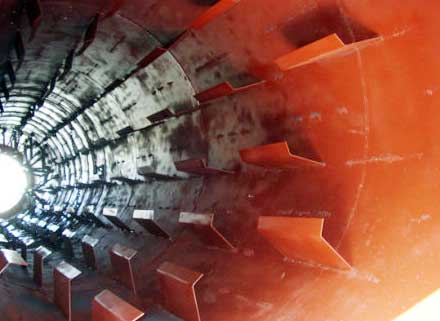
From the theory, the drying process of materials is divided into temperature heat raising, constant-speed drying, and reducing-speed drying.
The main functions of the rotary drum dryer flight are guiding, averaging, lifting, and material blocking, and orderly controlling the movement and drying process of the material in the cylinder. Therefore, the structural form of flight should be combined with the physical and chemical properties of different materials and the characteristics of the materials in each stage of the drying process.
The traditional rotary drum dryer has a simple structure and a single geometric shape. Under certain conditions of speed, only the material can be fixed in the section I, causing the hot air to be “opened” in zone I; in the zone II and III, a large “hole” is formed, which makes the hot air “short-circuit” (see pic below). Therefore, the thermal efficiency of the traditional rotary drum dryer is very low, and the moisture evaporation intensity of the material is <40 kg/m3·h.

In order to improve the performance of flight, in recent years, people have developed a combination of multiple geometric angles, spiral cross misalignment arrangement. These kinds of flights enable the material to be rapidly advanced from the heating and heating stage to the constant-speed drying stage, and at this stage, the material is formed into a thin and uniform “screen”, which increases the contact area between the material and the hot gas stream. Since this layer of “curtain” is formed by a chamfered surface and is propelled in a spiral shape, does not affect the flow rate of the hot gas flow, and can enhance the heat transfer and mass transfer of the material, thereby greatly improving the drying efficiency of the rotary drum dryer, and its moisture The evaporation intensity is >60 kg/(m3·h), makes the energy saving effect very remarkable.
Insulation of the rotary drum dryer drum
The drum of the rotary drum dryer is generally made of steel plate of 10 to 16 mm thick, and the length of the drum is generally more than 12 m. The temperature of the inlet wind is about 800 °C, the temperature of the outlet wind is about 100 °C, and the heat loss of the drum is about 8%.
For example, the 2. 2 m × 14 m rotary drum dryer (2.2m diameter, 14m long)has a slag drying capacity of 480 t/d and standard coal consumption of 25 kg/t. The heat loss caused by the heat dissipation of the drum is converted to 960 kg/d of standard coal.
According to the 300 working days of the year, about 288 tons of standard coal is wasted every year. According to empirical data, the rotary drum dryer evaporates 1 kg of water, and the heat consumption is 4,812.8 kJ/kg without insulation. After heat preservation, heat consumption is only 3,976.00 kJ/kg. That is quite much different consumption.
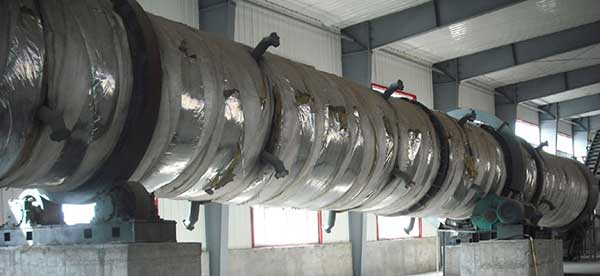
The external insulation of the drum is not complicated, and the cost of technical transformation is not high, only equivalent to 1/4 of the annual energy loss value. Commonly used insulation materials mainly include composite silicate insulation coatings, silicate fiberboards, mineral wool boards, and the like. Due to the long-term rotation of the drum, in order to prevent the insulation material from falling off, the insulation layer should be reinforced with a wire mesh. After the drum is insulated, the heat dissipation of the drum is reduced, the temperature of the inner wall is increased, the temperature of the hot gas is slowed down, and the temperature difference with the material is expanded, thereby accelerating the heat transfer rate and improving the heat transfer efficiency. Therefore, the drum insulation not only reduces heat loss, but also plays an important role in increasing the output and drying effect of the rotary drum dryer.
Reduce air leakage
It mainly refers to the problem of air leakage. The leakage of the rotary drum dryer mainly includes three parts: the inlet (the inlet of the slide), the seal and the discharge port. Leakage can damage the system’s hot gas flow, change the flow distribution of the gas flow, and reduce the flow rate of the flue gas. The leaking cold air will cause the temperature of the rotary drum dryer to decrease, the heat transfer speed to slow down, and the heat transfer efficiency to decrease. The load of the induced draft fan and the dust collector reduces the solid-gas separation efficiency of the cyclone, which directly leads to the lower output of the rotary drum dryer, increased energy consumption and shortened service life. For the three main air leakage parts of the rotary drum dryer, the following measures can be taken:
- Feed inlet: blanking with double flap valve;
- Sealing ring: using graphite slider elastic sealing ring;
- Discharge port: lengthen the discharge pipe of the tailing cover and install a single flap valve on the discharge pipe.
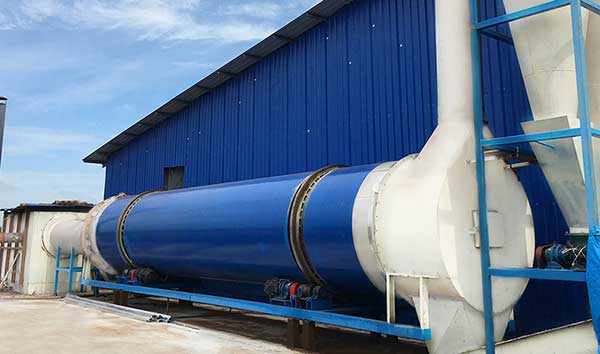
These 6 points are the main part of the energy-saving renovation of the rotary drum dryer. The enterprise can choose according to its own situation and has a focus on the project, and can carry out individual transformation or comprehensive technical transformation. Production practice has proved that the same drying production line, after technical transformation, can greatly increase the output of the rotary drum dryer, significantly reduce energy consumption, ensure the final moisture content, and the comprehensive benefits are considerable.
